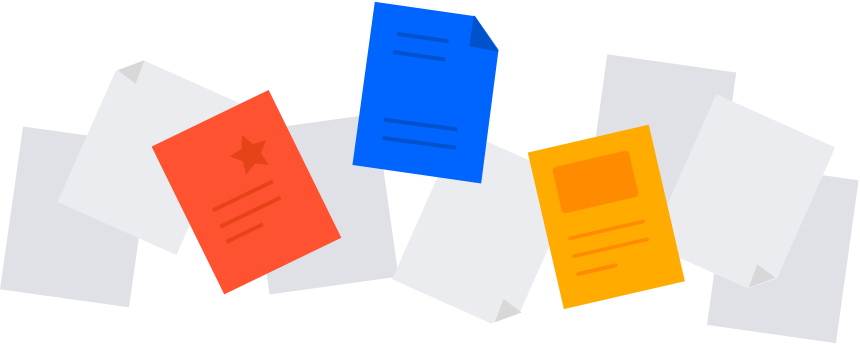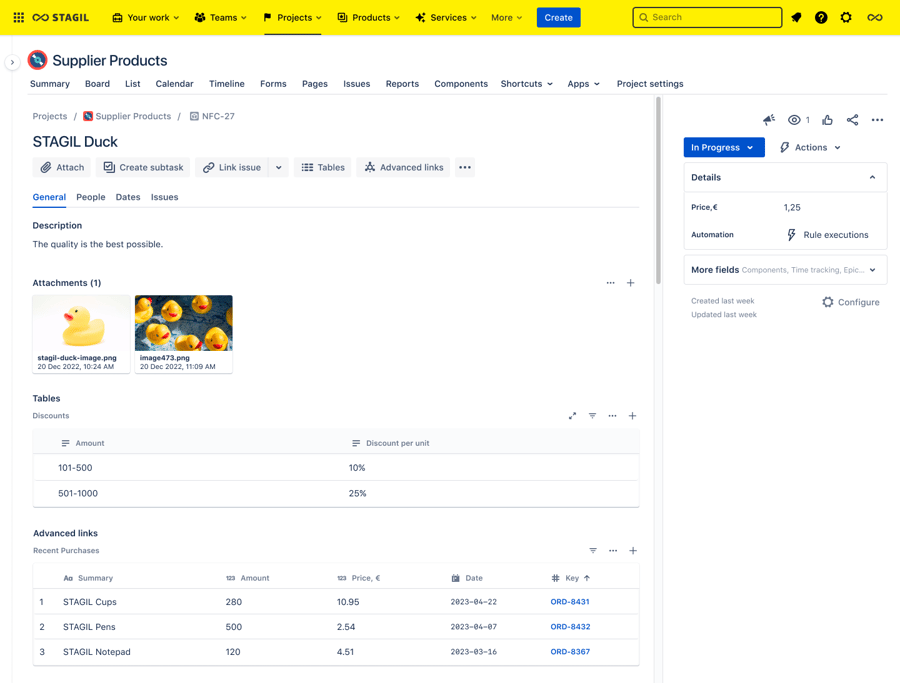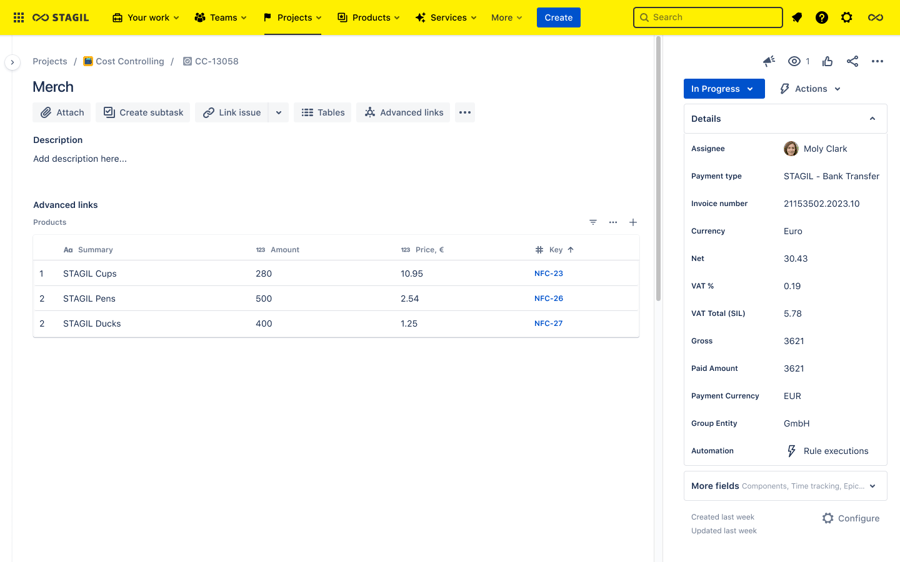Procurement processes are a critical part of modern businesses
Effective procurement management ensures that businesses are able to source the materials, services, and products they need to operate, while also managing costs, risks, and compliance requirements. However, managing procurement tasks can be challenging. This is where technology can help. By leveraging Atlassian tools, businesses can streamline procurement processes, improve collaboration, and gain better visibility into procurement tasks.
Get started!Procurement Process Overview:
The procurement process can be divided into several stages or phases, including planning, requisition, supplier selection, contract negotiation, purchase order creation, goods or service receipt, payment processing, and evaluation. Each stage of the process involves specific tasks and stakeholders. For example, during the planning stage, businesses will identify the materials or services they need, determine the budget, and develop a procurement plan. During the supplier selection stage, businesses will research potential suppliers, evaluate their capabilities, and select the supplier that best meets their needs. The contract negotiation stage involves developing and finalizing the contract terms and conditions with the selected supplier.
Boost Your Procurement Strategy with Jira
Map all your suppliers
One of the key benefits of using Jira for procurement is the ability to map all your suppliers in one centralized location. By using Jira, you can easily store and manage supplier information, such as contact details, certifications, and performance metrics. This makes it easy to track and manage supplier relationships and ensure that you are working with the right suppliers for your needs.
Map supplier products and services
Jira also allows you to map supplier products and services, making it easy to understand which suppliers can provide which goods and services. By mapping this information in Jira, you can quickly identify the right suppliers for specific procurement needs, streamline the procurement process, and ensure that you are getting the best value for your money.
Connect to invoices and cost controlling
Another key benefit of using Jira for procurement is the ability to connect to invoices and cost-controlling systems. By integrating Jira with these systems, you can easily track and manage costs associated with procurement, monitor budgets and spending, and ensure that you are staying within your financial limits. This can help you to optimize your procurement process and ensure that you are getting the best value for your money.
Steps for effective procurement management:
Planning
The first stage of the procurement process is planning. This involves identifying the need for goods or services, determining the requirements for those goods or services, and developing a procurement plan that outlines the procurement process and procedures.
Sourcing
The second stage of the procurement process is sourcing. This involves identifying potential suppliers and soliciting bids or proposals from those suppliers. The sourcing stage may also involve conducting supplier evaluations and negotiations to ensure that the selected suppliers meet the organization's requirements and provide the best value.
Contracting
The third stage of the procurement process is contracting. This involves developing and executing contracts with the selected suppliers, including negotiating terms and conditions, defining the scope of work, and establishing performance metrics and standards.
Order Placement
The fourth stage of the procurement process is order placement. This involves placing purchase orders with the selected suppliers, specifying the goods or services to be acquired, delivery dates, and payment terms.
Receipt and Inspection
The fifth stage of the procurement process is receipt and inspection. This involves receiving the goods or services from the suppliers, verifying that they meet the specifications outlined in the purchase order, and conducting any necessary inspections or quality control measures.
Payment
The final stage of the procurement process is payment. This involves processing invoices from the suppliers, verifying that the goods or services have been received and meet the specified requirements, and authorizing payment.
Software for Procurement:
STAGIL Assets (Advanced links management & Data model)
Atlassian Jira
Atlassian Confluence
Bitbucket
Procurement process mapping
visualize the steps of the procurement process and document them in a structured way
The first step in procurement process mapping is to identify the major activities or stages involved in the procurement process. This may include activities such as identifying the need for goods or services, sourcing suppliers, negotiating contracts, placing orders, receiving goods or services, and processing payments.

The first step in procurement process mapping is to identify the major activities or stages involved in the procurement process. This may include activities such as identifying the need for goods or services, sourcing suppliers, negotiating contracts, placing orders, receiving goods or services, and processing payments.

Task Section Division
Dividing procurement processes into task sections offers several benefits for businesses. It helps to break down complex processes into smaller, more manageable tasks, which improves clarity and reduces the risk of errors. Task section division also makes it easier to assign tasks to specific stakeholders, track progress, and ensure that tasks are completed on time. In addition, the task section division helps businesses to identify bottlenecks in the procurement process and improve overall efficiency.
In a procurement process, certain tasks may depend on other tasks' completion. For example, creating a purchase order may depend on vendor selection completion. To ensure that procurement processes run smoothly, it is important to identify and manage dependencies between task sections. This may involve setting up a workflow in a tool like Jira to automatically route tasks based on their dependencies.
Key benefits of using Atlassian Tools for procurement
Atlassian Tools can be beneficial for managing procurement processes by providing a centralized platform for collaboration, task management, and reporting.
Improved collaboration
Atlassian Tools such as Jira and Confluence provide a centralized platform for stakeholders to collaborate on procurement tasks. This improves communication, reduces errors, and ensures that everyone is working towards the same goals.
Streamlined procurement processes
By using Atlassian Tools to manage procurement tasks, businesses can streamline their procurement processes, reduce cycle time, and increase efficiency.
Better visibility
Atlassian Tools provide real-time visibility into procurement activities, allowing businesses to track the progress of procurement tasks, identify bottlenecks, and make data-driven decisions.
Enhanced reporting
Atlassian Tools provide powerful reporting and analytics capabilities, allowing businesses to generate custom reports and dashboards that provide insights into procurement performance.
Customizable workflows
Atlassian Tools such as Jira allow businesses to create customizable workflows that align with their specific procurement processes. This ensures that procurement tasks are completed consistently and efficiently.
Procurement template
Track all purchases from request to receipt
Customized request creation: Tailor your procurement workflow to reflect your team’s unique purchase process.
Built-in purchase tracking: Add quotes, proposals, and due dates to every order to simplify procurement management and filter for issues.
Powerful reporting: Use a range of reports that identify trends on specific people, projects, versions, or issues.
Metrics and KPIs are important for measuring the effectiveness of procurement processes
Cycle time
the time it takes to complete a procurement process from start to finish
Cost savings
the amount of money saved by optimizing procurement processes
Quality of goods or services procured
the percentage of goods or services that meet quality standards
Contract compliance
the percentage of contracts that are adhered to by both the business and the supplier
Stakeholder satisfaction
the satisfaction levels of stakeholders with the procurement process and its outcomes.
Related Solutions:
Requirements Management
Asset Management
Cost tracking







.png?width=64&height=64&name=ITIL%20Foundation%20(2).png)





